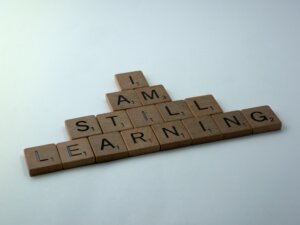
About Carter McNamara, MBA, PhD ~
Carter, of Authenticity Consulting, LLC, has helped organizations across the nation to design Action Learning programs.
Typically Mentioned Outcomes from Action Learning
The peer-based Action Learning process is known worldwide as a straightforward, yet powerful approach to personal, professional and organization development. Standard outcomes frequently mentioned from the process include skills in listening, consulting, facilitation, reflection, inquiry, problem solving and organization development. Particular outcomes from the process depend on the design of the Action Learning program and members’ selection of projects to work on in their sets.
I have learned over the years that trainers and employers also highly value Action Learning to enhance “one-shot” training sessions. Few other development are as effective in forming local learning communities to deepen and enrich training from these “one-shot” sessions. This article provides guidelines to design and facilitate these local learning communities to complement courses, workshops and seminars.
Increasing Use of Training and Development
Organizations invest in training like never before. There are numerous reasons for this increased priority on training. Recent advances in telecommunications have opened markets for businesses across the world. Key to success is effective recruiting and training of workers, particularly in the areas of marketing, sales and service. Technologies have become more important, yet more complex to understand and operate. One can hardly imagine a role in an organization where employees do not need to understand how to use a computer or have strong skills in customer service. Increased diversity and public consciousness have combined to cause an explosion of rules and regulations under which businesses must operate. Businesses must ensure that employees understand and work according to these rules and regulations.
Market research indicates that today’s adults strongly prefer lifelong learning in the form of workshops and seminars. There is an explosion of training centers geared to provide courses, seminars and workshops on topics ranging from basket-weaving to chaos theory.
Training Conducted as Ineffective “One-Shot” Sessions
Too often, employers, trainers and learners resort to “one-shot”, quick-fix training sessions. These are usually half- or full-day sessions in which an expert conveys information and materials needed to develop certain skills. While these sessions can be effective in conveying “programmed” information, they are not likely to actually develop skills in learners. Development of skills requires ongoing effective application of new information. One-shot training sessions hardly afford the time and ongoing guidance for effective skill development.
One-shot training sessions are difficult to evaluate as well. Trainers are constrained to hand out “reactionnaires” at the end of sessions. While this form of evaluation may be useful to gather learners’ reactions to the sessions, they are invalid means to assess and judge how well learners have mastered application of materials from the sessions.
Breakthroughs in Training Formats Are Slow to Come
Despite these problems with one-shot trainings, they remain the hallmark of development. Businesses leaders often prefer quick-fix workshops and seminars for busy employees. One-shot training sessions are far easier for trainers to schedule and carry out.
Businesses and trainers look in the wrong places to fix the problem with one-shot training sessions. They fine tune design of training materials. They provide more books and binders. They exhort learners to apply training materials after the sessions are over. They remind learners that there is no knowledge without practice. Still, learners books and binders collect dust on their shelves.
Breakthroughs are slow to come also because, too often, we assume developments are powerful only if they seem complex, novel or out of the mouths of our latest gurus. We believe the more expensive the model or training program, the more powerful it must be (this is the fallacy of “executive-level pricing”).
Perhaps the answer to increased effectiveness in training and development is not to be found in producing yet more models or holding more sessions? Perhaps the answer is much closer – and easier to apply – than we think.
Benefits of Action Learning to Enrich Training
There are many benefits to using the Action Learning process to form local learning communities to enrich “one-shot” trainings. For example:
- Communities are straightforward to integrate with training sessions and are easy to organize.
- In groups, members hold each other accountable to actually apply new materials from training sessions.
- Members share learning and other result from the sessions.
- Members support each other to take risks and learn.
- Communities are inexpensive to implement. Trainers can charge a nominal fee to members to recover costs of time and materials, or members can facilitate their own groups.
- Learners develop a network of peers who they can call for support and feedback.
Guidelines to Design Action Learning to Enrich “One-Shot” Trainings
Over the years, I’ve learned the following guidelines to optimize the Action Learning process in order to deepen and enrich learning from one-shot training sessions.
- All set members should be interested in learning the same topic or skill.
- Learners should value — or soon learn to value – self-directed learning and skills in reflection and inquiry. (I have my learners read the materials at https://management.org/training/methods/formal-and-informal-methods.htm#directed )
- Consider providing the sets on a voluntary basis, that is, learners can join the sets if they choose. Obviously, this arrangement cannot be provided if membership is required to earn a course grade or other form of verification of learning. If the sets are not voluntary, be clear that they are mandatory.
- The number of meetings and location of meetings might be determined by the trainer. However, the sets should meet at least six times.
- Avoid having the sets scheduled at the end of a long day of lecturing, if possible. Consider starting the day with a short lecture, then a set meeting, then a lunch break, then a short lecture and then a set session.
- As means of verification of learning from the set (e.g., for grading purposes), consider naturalistic and unfolding means of verification, for example, learning journals, reflective essays and portfolios.
- I stay away from learning contracts. It’s not unusual to find that learners can gain a great deal from a set without ever having achieved the outcomes they promised in their contracts. Instead, I use Letters of Participation. These follow my belief that if members participate wholeheartedly in their set, then their necessary outcomes will follow.
- I have rarely found it worth the while to assess each learner’s learning style and design sets accordingly. If each member participates wholeheartedly in their set, they will certainly accomplish at least that 20% of effort that generates 80% of learning for the learner.
- Ensure that materials and information from the course, seminar, workshop, etc., are integrated with the set process, for example, have the seminar trainer mention the set and how members might use their time slots relative to the materials and information in the seminar. Ensure that the trainer knows about the sets and their use in the overall training program.
- Provide clear guidelines about what learners are to do in their sets as compared to what they are to do in their courses, seminars, workshops, etc. As to what members specifically do in their sets, read the next section.
- Conduct the standard opening and check-in for the set meeting. Have each member very briefly describe what they plan to work on in the meeting, how they are feeling today, etc. Then go into each member’s time slot.
Design the meeting so each member gets at least 15 minutes for their time slot. (Although this time might seem small, learners often report that they learn the most while helping other members and during reflection between meetings.) - During their time slots, each presenter should address the following questions:
a) What were the top two to four learnings for them from the current training session?
b) How they will apply this new learning before the next set meeting?
c) What will that application look like? What would someone else see if they watched the learning applying the new learning?
d) Do they need any help from fellow set members before the next set meeting, and if so, what kind of help? - At the end of each session, each member:
a) Verbally rates (out loud) the quality of the meeting from 1-5 with 1 representing a poor meeting,
b) Explains why they gave the rating that they did, and
c) What they could have done in the meeting to help the meeting get a higher rating.
Summary
I have used Action Learning to enrich one-shot trainings for well over a decade now. This application of Action Learning has fast become one of my major consulting services. I firmly believe that the biggest obstacle to the use of local learning communities around one-shot training is the limited mindset of the trainer. I encourage readers to experiment with their own designs and share their learnings with us, as well.
—
For more resources about training, see the Training library.
The Free Management Library is at www.managementhelp.org on the Web. Carter can be reached at [email protected] and his business is described at www.authenticityconsulting.com on the Web.
 Sections of this topic
Sections of this topic















